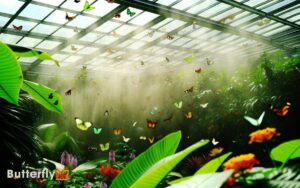Can You Milk a Butterfly? Exploring the Myth!
You can’t milk a butterfly since they don’t have specialized glands for milk production. Instead, butterflies use a proboscis to siphon nectar from flowers.
Some butterflies do secrete other substances, like pheromones for mating or toxins for defense. Butterflies show fascinating adaptations for survival; exploring these can reveal more intricate aspects of their biology.

Key Takeaways
Understanding Butterfly Anatomy
To understand the possibility of milking a butterfly, you must first explore the intricacies of butterfly anatomy. Butterflies possess a proboscis, a specialized mouthpart designed for siphoning nectar, not for secretion.
Their exoskeleton provides structural support but lacks any mammalian-like glands for milk production. Internally, the digestive system processes liquid nutrients, while the reproductive organs handle egg-laying.
Hemolymph, their circulatory fluid, moves through an open system, distinct from blood in vertebrates. Their wings, covered in microscopic scales, facilitate flight but don’t contribute to fluid production.
Understanding these anatomical features clarifies that butterflies lack the necessary physiological structures for traditional milking. Recognizing these limitations helps you grasp the biological constraints involved in the hypothetical concept of milking a butterfly.
What Does ‘Milking’ Mean?
Milking, in its most fundamental sense, generally refers to the extraction of a liquid substance from an organism, typically involving specialized glands. In mammals, this process is straightforward, involving the mammary glands.
However, when considering insects like butterflies, the concept becomes more complex. Butterflies lack traditional glands akin to mammary glands in mammals. Additionally, butterflies rely on entirely different methods to nourish their young, such as laying eggs on host plants that provide food for emerging larvae. This distinction highlights the vast differences in reproductive and feeding strategies among various insect species. Observing phenomena like a praying mantis eating butterflies further emphasizes the complexity of predator-prey relationships in the insect world.
| Organism | Substance Extracted | Method of Extraction |
|---|---|---|
| Cow | Milk | Suckling or mechanical pumps |
| Venomous Snake | Venom | Venom milking |
| Butterfly | N/A | N/A |
| Spider | Silk | Induced spinning |
| Bee | Honey | Hive collection |
Insects, including butterflies, don’t produce liquid substances through specialized glands suitable for “milking.” Consequently, “milking” a butterfly in the traditional sense isn’t feasible.
Historical Perspectives
Examining historical perspectives on entomological practices, you’ll find that early naturalists often misunderstood the physiology and behaviors of butterflies. They lacked the sophisticated tools and methodologies we’ve today.
Many believed butterflies were ephemeral creatures with mystical qualities, often attributing their metamorphosis to magical processes rather than biological ones.
Early documentation is filled with inaccuracies; for example, some thought butterflies could generate substances similar to mammalian milk.
Without our current understanding of lepidopteran anatomy, these misconceptions persisted. Descriptions from the 17th and 18th centuries reveal limited knowledge about proboscis function and nectar feeding.
These historical inaccuracies highlight how far entomology has come, paving the way for modern, evidence-based approaches to studying these fascinating insects.
Scientific Research Findings
Modern scientific research reveals that butterflies utilize their proboscis to feed on nectar and other liquid substances, debunking earlier misconceptions about their ability to produce milk-like substances.
You’ll find that a butterfly’s proboscis is a highly specialized organ, functioning much like a straw, allowing them to efficiently extract nutrients.
Studies using electron microscopy have shown that the proboscis is composed of intricate tube-like structures that can coil and uncoil. This adaptability aids in accessing various floral nectars.
Researchers also employ isotopic labeling to trace nutrient absorption pathways, confirming that butterflies lack mammalian milk production mechanisms.
Understanding this helps clarify their actual feeding behaviors and ecological roles, aligning with the broader knowledge of Lepidoptera physiology.
Butterfly Metabolism
Butterfly metabolism involves a complex interplay of biochemical processes that convert ingested nectar into usable energy for flight, reproduction, and other essential functions.
You’ll find that enzymes break down sugars in nectar, primarily sucrose, into glucose and fructose. These simpler sugars enter the glycolysis pathway, producing ATP, the cellular energy currency.
The citric acid cycle further breaks down these molecules, generating more ATP and essential metabolic intermediates. The electron transport chain, located in the mitochondria, maximizes ATP production through oxidative phosphorylation.
Here’s a simplified overview:
| Process | Input | Output |
|---|---|---|
| Glycolysis | Glucose, Fructose | ATP, Pyruvate |
| Citric Acid Cycle | Pyruvate | ATP, CO₂, NADH, FADH₂ |
| Electron Transport | NADH, FADH₂ | ATP, H₂O |
Understanding these pathways helps you appreciate how butterflies sustain their essential activities.
Nectar and Nutrients
Drawing nectar from flowers, butterflies extract essential nutrients necessary for their energy-intensive activities like flight and reproduction. You’ll notice they use their proboscis, a specialized feeding tube, to access nectar deep within flowers.
This nectar contains sugars, primarily sucrose, glucose, and fructose, providing immediate energy.
Additionally, butterflies obtain amino acids, important for protein synthesis and overall metabolic function. Some species also derive essential minerals like sodium from nectar, important for nerve and muscle performance.
You might observe butterflies engaging in mud-puddling, a behavior where they extract salts and other minerals from moist soil, supplementing their nectar-based diet.
By understanding these dietary needs, you can appreciate the complexity of their nutritional ecology and its impact on their life cycles and behaviors.
Pheromones and Secretions
Many butterfly species use pheromones and other secretions to communicate, attract mates, and ward off predators.
You’ll find that male butterflies often release pheromones from specialized structures called androconia, located on their wings or abdomens. These chemical signals play an essential role during courtship rituals. During mating, the butterfly position in sex involves the male and female joining at their abdomens while facing opposite directions. This positioning allows the male to effectively transfer sperm while his pheromones help reinforce the bond. These chemical signals ensure successful reproduction by attracting receptive females and enhancing mating success.
Female butterflies can detect these pheromones using their antennae, which are equipped with sensitive chemoreceptors.
Concerning defense, some butterflies secrete toxic substances from glands, deterring predators. For example, the Monarch butterfly’s larvae store toxins from milkweed, which they then secrete as adults.
Additionally, some species produce an anti-aphrodisiac pheromone after mating to make the female less attractive to other males, ensuring their own genetic success.
Understanding these mechanisms reveals the complexity of butterfly behavior.
Practical Applications
In light of their intricate chemical communication systems, researchers are exploring practical applications of butterfly pheromones in fields such as pest control and agriculture.
You can leverage these pheromones to disrupt mating cycles of pest species, reducing reliance on harmful pesticides.
By synthesizing and deploying these natural chemicals, you create targeted control methods that are both environmentally friendly and species-specific. Additionally, butterfly pheromones could enhance pollination efficiency.
When you introduce these compounds into crops, you might attract beneficial insects, boosting pollination rates and crop yields.
The precise application of butterfly pheromones signifies a breakthrough in sustainable agriculture, providing a nuanced approach to ecosystem management that aligns with ecological preservation and agricultural productivity.
Ethical Considerations
While butterfly pheromones offer promising advancements in sustainable agriculture, you must also consider the ethical implications of manipulating natural chemical communications.
Extracting pheromones can disrupt butterfly behavior, affecting mating patterns and ecological balance. You should evaluate whether the benefits outweigh the potential harm to these delicate ecosystems.
Additionally, the process involves handling live specimens, raising concerns about their welfare and stress levels. Ethical guidelines mandate minimizing harm and ensuring that any interference serves a greater ecological or agricultural benefit.
You must also contemplate long-term consequences, such as potential resistance or adaptation among butterfly populations.
Balancing innovation with ethical responsibility is essential to maintaining biodiversity while leveraging these natural compounds for agricultural enhancement.
Myths and Misconceptions
You’re probably familiar with the myth that butterflies can be milked, but this misconception overlooks their unique anatomical structure.
Butterflies lack mammary glands, which are essential for milk production in mammals.
Common Misunderstandings Explained
Many people mistakenly believe butterflies can be milked like dairy cows, but this myth ignores fundamental differences in anatomy and physiology. Butterflies lack mammary glands, the specialized structures in mammals that produce milk.
Instead, they possess a proboscis for nectar feeding. Nectar provides essential nutrients, but it’s not analogous to milk. Additionally, butterflies undergo complete metamorphosis, transforming from larva to adult, a process that doesn’t involve milk production.
Their digestive and reproductive systems are also vastly different from mammals. Understanding these distinctions helps debunk the myth and clarifies that milking a butterfly is biologically impossible.
Grasping these concepts is important for appreciating the unique biological processes governing butterflies and avoiding misconceptions.
Butterfly Anatomy Facts
Butterflies possess fascinating anatomical structures like the proboscis for feeding, compound eyes for wide-angle vision, and scales on their wings that create vibrant colors through structural coloration.
The proboscis acts like a drinking straw, uncoiling to sip nectar. Their compound eyes, composed of thousands of ommatidia, provide extensive visual coverage, aiding in detecting predators and locating flowers.
Wing scales, arranged in overlapping layers, interact with light to produce iridescent hues via microscopic ridges and grooves.
Contrary to some beliefs, butterflies don’t have bones; they’ve an exoskeleton made of chitin. Understanding these structures helps clarify how butterflies navigate their environment and interact with their ecosystem, dispelling myths and highlighting their complex biology.
Debunking Popular Beliefs
One common misconception is that butterflies drink milk, when in fact, their diet consists primarily of nectar, tree sap, and occasionally, minerals from mud puddles. Butterflies use their proboscis, a specialized feeding tube, to extract these liquids.
The idea of ‘milking’ a butterfly is scientifically inaccurate because butterflies lack mammary glands, a requirement for milk production. Additionally, their digestive systems are adapted to liquid diets, focusing on extracting sugars and essential nutrients.
This myth likely stems from anthropomorphizing butterflies, attributing them with mammalian traits. By understanding the butterfly’s biological structure and feeding habits, you can appreciate their role as pollinators and their contribution to ecosystems, free from misconceptions.
Future Research Directions
Future research should focus on developing advanced micro-extraction techniques to effectively harvest trace amounts of fluid from butterfly proboscises for biochemical analysis.
You should aim to refine these techniques to minimize harm to the butterflies and obtain high-quality samples.
Key areas to explore include:
- Nanotechnology-based extraction tools: Designing ultra-fine instruments to interact with the delicate proboscis.
- High-throughput screening methods: Implementing automated systems to analyze multiple samples rapidly and accurately.
- Genetic expression profiling: Investigating gene activity related to fluid secretion and absorption processes.
Conclusion
You’ve now explored the fascinating world of butterfly anatomy, metabolism, and the concept of ‘milking.’
Surprisingly, researchers found that a butterfly’s proboscis can absorb tiny amounts of fluid at a rate of 0.3 microliters per second. This fact underscores the delicate and complex physiology of these creatures.
While practical applications remain limited, continued research could reveal new biological insights. Always consider the ethical implications when studying these intricate beings.
Future studies promise to further illuminate these tiny marvels.






